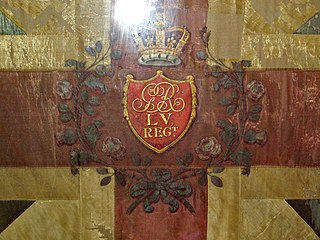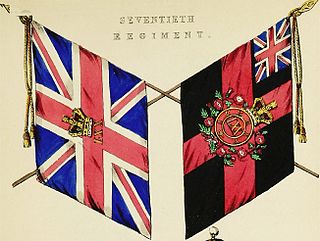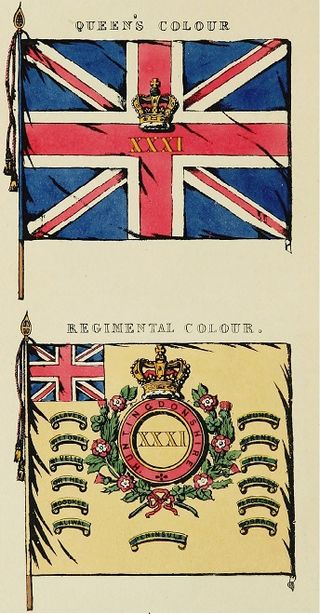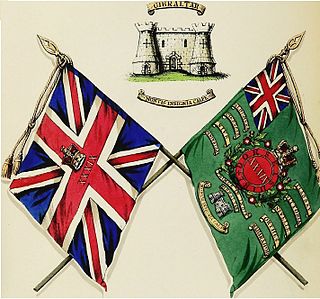The 47th (Lancashire) Regiment of Foot was an infantry regiment of the British Army, raised in Scotland in 1741. It served in North America during the Seven Years' War and American Revolutionary War and also fought during the Napoleonic Wars and the Crimean War. Under the Childers Reforms it amalgamated with the 81st Regiment of Foot to form the Loyal Regiment in 1881.

The Cheshire Regiment was a line infantry regiment of the British Army, part of the Prince of Wales' Division. The 22nd Regiment of Foot was raised by the Henry Howard, 7th Duke of Norfolk in 1689 and was able to boast an independent existence of over 300 years. The regiment was expanded in 1881 as part of the Childers Reforms by the linking of the 22nd (Cheshire) Regiment of Foot and the militia and rifle volunteers of Cheshire. The title 22nd (Cheshire) Regiment continued to be used within the regiment.
The 28th Regiment of Foot was a line infantry regiment of the British Army, raised in 1694. Under the Childers Reforms it amalgamated with the 61st Regiment of Foot to form the Gloucestershire Regiment in 1881.

The 53rd (Shropshire) Regiment of Foot was a British Army regiment, raised in 1755. Under the Childers Reforms it amalgamated with the 85th Regiment of Foot to form the King's Shropshire Light Infantry in 1881.

The 50th Regiment of Foot was an infantry regiment of the British Army, raised in 1755. Under the Childers Reforms it amalgamated with the 97th Regiment of Foot to form the Queen's Own Royal West Kent Regiment in 1881.

The Devonshire Regiment was a line infantry regiment of the British Army that served under various titles and served in many wars and conflicts from 1685 to 1958, such as the Second Boer War, the First World War and the Second World War. In 1958 the regiment was amalgamated with the Dorset Regiment to form the Devonshire and Dorset Regiment which, in 2007, was amalgamated with the Royal Gloucestershire, Berkshire and Wiltshire Regiment, the Royal Green Jackets and The Light Infantry to form a new large regiment, The Rifles.

The 42nd Regiment of Foot was a Scottish infantry regiment in the British Army also known as the Black Watch. Originally titled Crawford's Highlanders or the Highland Regiment and numbered 43rd in the line, in 1748, on the disbanding of Oglethorpe's Regiment of Foot, they were renumbered 42nd, and in 1751 formally titled the 42nd (Highland) Regiment of Foot. The 42nd Regiment was one of the first three Highland Regiments to fight in North America. The unit was honoured with the name Royal Highland Regiment in 1758. Its informal name Black Watch became official in 1861. In 1881, the regiment was amalgamated with 73rd (Perthshire) Regiment of Foot under the Childers Reforms into The Royal Highland Regiment , being officially redesignated The Black Watch in 1931. In 2006, the Black Watch became part of the Royal Regiment of Scotland.

The 55th Regiment of Foot was a British Army infantry regiment, raised in 1755. After 1782 it had a county designation added, becoming known as the 55th (Westmorland) Regiment of Foot. Under the Childers Reforms it amalgamated with the 34th (Cumberland) Regiment of Foot to form the Border Regiment in 1881.

The 70th (Surrey) Regiment of Foot was a regiment of the British Army, raised in 1756. Under the Childers Reforms it amalgamated with the 31st (Huntingdonshire) Regiment of Foot to form the East Surrey Regiment in 1881.

The 31st (Huntingdonshire) Regiment of Foot was an infantry regiment of the British Army, raised in 1702. Under the Childers Reforms it amalgamated with the 70th (Surrey) Regiment of Foot to form the East Surrey Regiment in 1881.

The Leicestershire Regiment was a line infantry regiment of the British Army, with a history going back to 1688. The regiment saw service for three centuries, in numerous wars and conflicts such as both World War I and World War II, before being amalgamated, in September 1964, with the 1st East Anglian Regiment, the 2nd East Anglian Regiment and the 3rd East Anglian Regiment to form the present day Royal Anglian Regiment, of which B Company of the 2nd Battalion continues the lineage of the Royal Leicestershire Regiment.

The East Yorkshire Regiment was a line infantry regiment of the British Army, first raised in 1685 as Sir William Clifton's Regiment of Foot and later renamed the 15th Regiment of Foot. It saw service for three centuries, before eventually being amalgamated with the West Yorkshire Regiment in 1958, to form the Prince of Wales's Own Regiment of Yorkshire. Subsequently, the regiment amalgamated with the Green Howards and the Duke of Wellington's Regiment to form the Yorkshire Regiment on 6 June 2006.

The 27th (Inniskilling) Regiment of Foot was an Irish infantry regiment of the British Army, formed in 1689. Under the Childers Reforms it amalgamated with the 108th Regiment of Foot to form the Royal Inniskilling Fusiliers in 1881.

The 36th (Herefordshire) Regiment of Foot was an infantry regiment of the British Army, raised in 1701. Under the Childers Reforms it amalgamated with the 29th (Worcestershire) Regiment of Foot to form the Worcestershire Regiment in 1881. Its lineage is continued today by the Mercian Regiment.

The 67th Regiment of Foot was a line infantry regiment of the British Army, raised in 1756. Under the Childers Reforms it amalgamated with the 37th Regiment of Foot to form the Hampshire Regiment in 1881.

The 39th (Dorsetshire) Regiment of Foot was an infantry regiment of the British Army, raised in 1702. Under the Childers Reforms it amalgamated with the 54th Regiment of Foot to form the Dorsetshire Regiment in 1881.
The 48th (Northamptonshire) Regiment of Foot was a regiment of the British Army, raised in 1741. Under the Childers Reforms it amalgamated with the 58th (Rutlandshire) Regiment of Foot to form the Northamptonshire Regiment in 1881.

The 43rd (Monmouthshire) Regiment of Foot was an infantry regiment of the British Army, raised in 1741. Under the Childers Reforms it amalgamated with the 52nd (Oxfordshire) Regiment of Foot to form the 1st and 2nd battalions of the Oxfordshire Light Infantry in 1881. The regiment went on to become the Oxfordshire and Buckinghamshire Light Infantry in 1908.
The 59th Regiment of Foot was an infantry regiment of the British Army, formed in 1755 in response to the threat of renewed war with France. Under the Childers Reforms it amalgamated with the 30th (Cambridgeshire) Regiment of Foot to form the East Lancashire Regiment in 1881.

The 49th (Hertfordshire) Regiment of Foot was a line infantry regiment of the British Army, raised in 1743. Under the Childers Reforms it amalgamated with the 66th (Berkshire) Regiment of Foot to form the Princess Charlotte of Wales's in 1881.




















